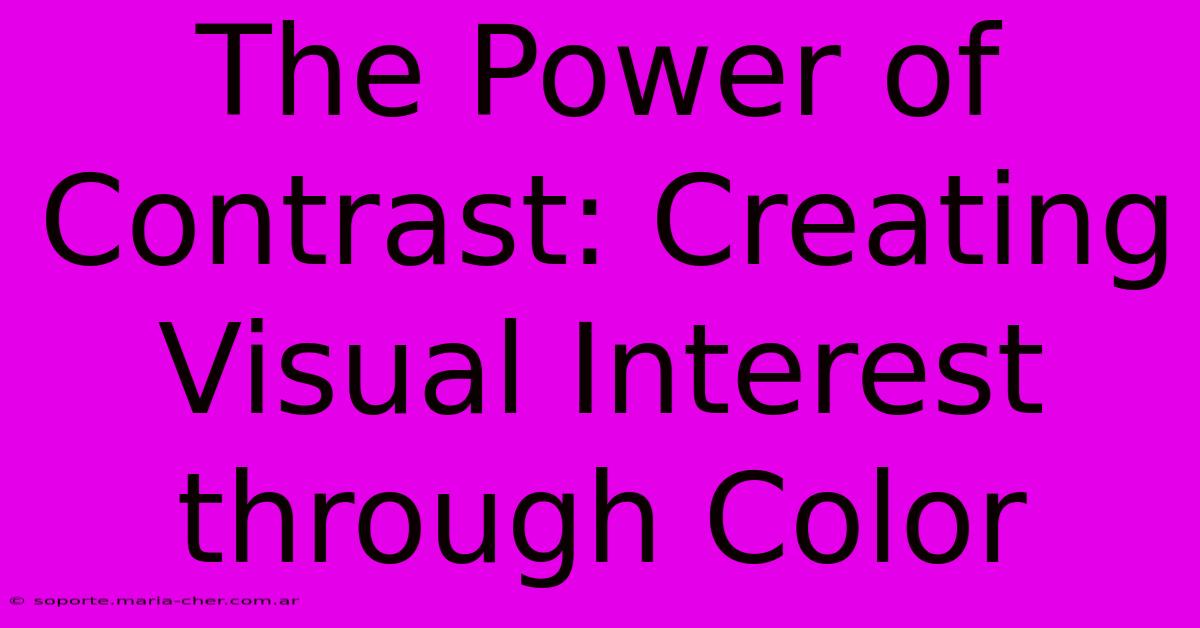The Power Of Contrast: Creating Visual Interest Through Color

Table of Contents
The Power of Contrast: Creating Visual Interest through Color
Color is a powerful tool. It evokes emotion, sets the mood, and guides the eye. But using color effectively goes beyond simply picking pretty hues. Mastering the power of contrast is key to creating visually compelling designs, whether you're a graphic designer, photographer, or simply someone who wants to improve their Instagram feed. This article delves into the art of color contrast and how you can leverage it to boost the impact of your visuals.
Understanding Color Contrast: More Than Just Light and Dark
Color contrast refers to the difference between two or more colors. High contrast means colors are vastly different, while low contrast suggests colors are similar. But it's not just about light versus dark; contrast also involves:
- Hue: The pure color (e.g., red, blue, green). Contrasting hues are those that are far apart on the color wheel.
- Saturation: The intensity or purity of a color. A highly saturated color is vibrant, while a desaturated color is muted or pastel. Contrasting saturation can be equally effective.
- Brightness/Value: How light or dark a color is. This is often the most obvious form of contrast.
Why is Contrast Important?
Strong contrast is essential for several reasons:
- Improved Readability: In designs with text, high contrast between text and background is crucial for ease of reading and accessibility. Think of a black font on a white background – a classic example of high contrast.
- Visual Hierarchy: Contrast helps guide the viewer's eye to important elements. A highly contrasting color can draw attention to a call to action, a product image, or a key piece of information.
- Enhanced Aesthetics: Well-used contrast creates a visually stimulating and dynamic design. It prevents monotony and adds interest to your work.
- Increased Accessibility: Sufficient color contrast is vital for users with visual impairments. WCAG (Web Content Accessibility Guidelines) provides specific guidelines for ensuring sufficient contrast ratios for web design.
Types of Color Contrast: Exploring Different Techniques
There are various ways to create contrast using color:
1. Complementary Colors: Opposite Attract
Complementary colors sit directly opposite each other on the color wheel (e.g., red and green, blue and orange, yellow and purple). These combinations create a vibrant and energetic feel. Use them sparingly, however, as they can be quite intense.
2. Analogous Colors: Harmonious Hues
Analogous colors are located next to each other on the color wheel (e.g., blue, blue-green, and green). They create a harmonious and serene effect, ideal for calming visuals.
3. Triadic Colors: A Balanced Trio
Triadic colors are evenly spaced around the color wheel (e.g., red, yellow, and blue). They offer a balanced and visually appealing contrast.
4. Monochromatic Colors: Shades and Tints
Monochromatic color schemes use variations of a single color, ranging from light tints to dark shades. This creates a sophisticated and unified look, ideal for branding and minimalist designs.
Practical Applications of Color Contrast: Examples in Action
- Website Design: Use high contrast between text and background for optimal readability. Employ contrasting colors for call-to-action buttons to make them stand out.
- Photography: Consider the contrast between your subject and its background. A brightly lit subject against a dark background creates a dramatic effect.
- Graphic Design: Utilize contrasting colors to highlight key elements in posters, brochures, or marketing materials.
- Social Media: Use contrasting colors in your images and graphics to create visually appealing posts that grab attention in a crowded feed.
Tools and Resources for Exploring Color Contrast
Several tools can help you explore and experiment with color contrast:
- Adobe Color: A website offering a variety of color schemes and tools for creating color palettes.
- Coolors: A popular website for generating random color palettes and exploring different color combinations.
Conclusion: Mastering Contrast for Visual Success
Understanding and effectively utilizing color contrast is a critical skill for anyone working with visual media. By mastering the principles outlined above, you can elevate your designs, enhance readability, improve accessibility, and create visuals that are both beautiful and effective. Remember to experiment, explore different combinations, and find what works best for your specific needs and aesthetic goals. The power of contrast is in your hands!

Thank you for visiting our website wich cover about The Power Of Contrast: Creating Visual Interest Through Color. We hope the information provided has been useful to you. Feel free to contact us if you have any questions or need further assistance. See you next time and dont miss to bookmark.
Featured Posts
-
Elevate Your Photography With The Tamron 70 180mm G2 Unparalleled Zoom And Image Quality
Feb 09, 2025
-
Shocking Truth The Dark Side Of Polyester Microfiber Revealed
Feb 09, 2025
-
The Blurred Lines Uncovering The True Speed Kings Of The Diamond
Feb 09, 2025
-
Unveil The Magic Enchanting First Communion Invitations For Your Little Angel
Feb 09, 2025
-
Merry And Bright Our Festive First Christmas Card As A Couple
Feb 09, 2025
